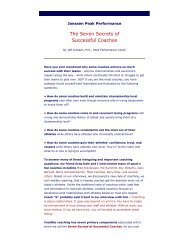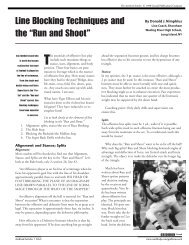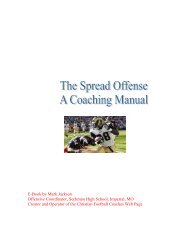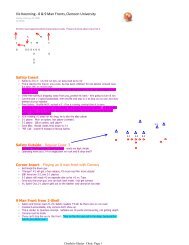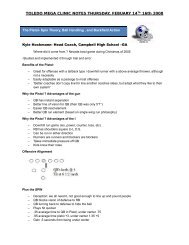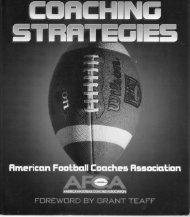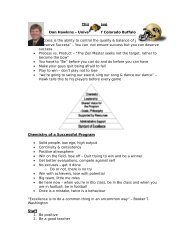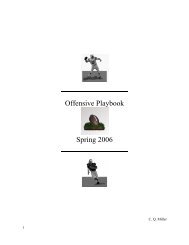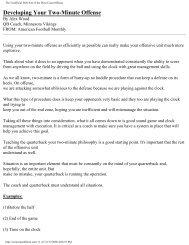Dare to Be Different: The Shield Punt - Fast and Furious Football
Dare to Be Different: The Shield Punt - Fast and Furious Football
Dare to Be Different: The Shield Punt - Fast and Furious Football
Create successful ePaper yourself
Turn your PDF publications into a flip-book with our unique Google optimized e-Paper software.
S3: Toes at eight yards from ball. Split<br />
six inches from S2.<br />
<strong>Punt</strong>er: Heels at 15 yards.<br />
Diagram 2: Release &<br />
Blocking Technique<br />
Release <strong>and</strong> Blocking Technique<br />
Front Line<br />
A: Your release technique is <strong>to</strong> take a<br />
lead step laterally, then cross over in<strong>to</strong> your<br />
release lane. <strong>The</strong> further the man in your<br />
lane is from you, the flatter your release<br />
must be <strong>to</strong> make sure he doesn’t penetrate<br />
the line of scrimmage without you making<br />
contact with him.<br />
B : Your blocking technique is <strong>to</strong> run<br />
through rushers. To achieve this type of<br />
blocking, it is important <strong>to</strong> keep your head<br />
up, maintain a good running base (slightly<br />
narrower than shoulder width) <strong>and</strong> keeping<br />
your h<strong>and</strong>s inside on the opponent’s<br />
numbers. It is important <strong>to</strong> run through<br />
rushers, not <strong>to</strong> brush them with your<br />
h<strong>and</strong>s or the edge of your shoulder. Keep<br />
your feet moving throughout the collision,<br />
which will s<strong>to</strong>p the rushers’ initial charge,<br />
<strong>and</strong> then release.<br />
C: If no one penetrates your release<br />
lane, avoid defenders trying <strong>to</strong> slow your<br />
coverage. If you are L1/R1, you must take<br />
your first step in<strong>to</strong> your release lane, <strong>and</strong> if<br />
you are being driven outside, you can<br />
come under the defender <strong>to</strong> get in<strong>to</strong> the<br />
alley.<br />
Diagram 3: L1/R1 Release Lanes<br />
Release Lanes<br />
L1/R1: Your release lane is from your<br />
outside shoulder <strong>to</strong> head-up on L2/R2<br />
L2/R2: Your release lane is from your<br />
outside shoulder <strong>to</strong> head-up on L3/R3<br />
L3/R3: Your release lane is from headup<br />
<strong>to</strong> anyone outside.<br />
Diagram 4: L2/R2 Release Lanes<br />
Diagram 5: L3/R3 Release Lanes<br />
Diagram 6: Release <strong>and</strong><br />
Blocking Technique<br />
<strong>Shield</strong><br />
As the ball is snapped, the shield must<br />
step up <strong>and</strong> in <strong>to</strong> close the distance<br />
between S1 <strong>and</strong> S2. After stepping a half<br />
yard up <strong>and</strong> in, the shield will then set<br />
themselves in a solid football position, with<br />
knees bent, butt down, head up <strong>and</strong> arms<br />
out. <strong>Be</strong>cause this is a zone protection<br />
scheme, the shield personnel may have <strong>to</strong><br />
block more than one rusher in their area. It<br />
is important that the shield think “Big,”<br />
punch with h<strong>and</strong>s inside, <strong>and</strong> above all, do<br />
not drop your helmets at collision!<br />
Diagram 7<br />
• AFCA Summer Manual — 1999 •<br />
Center<br />
A.<strong>The</strong> No. 1 responsibility is <strong>to</strong> make a<br />
crisp, accurate snap. It is better low <strong>and</strong><br />
around the right thigh of a right footed<br />
punter. <strong>The</strong> snap should reach the punter’s<br />
h<strong>and</strong> in .8 seconds. Notice the shield personnel<br />
will align in a position <strong>to</strong> give you a<br />
proper snapping lane <strong>to</strong> the punter. Use<br />
this lane as your guide.<br />
B. After “set” call by S1, you may snap<br />
the ball anytime. Always sprint <strong>to</strong> a head-up<br />
position on the ball. You are a ball man.<br />
<strong>Punt</strong>er<br />
A. <strong>The</strong> alignment should be with your<br />
heels at 15 yards from the ball.<br />
B. Give the snapper a high hip target<br />
with both h<strong>and</strong>s.<br />
C. <strong>Punt</strong> with a quick, smooth rhythm.<br />
D. After punt, give a directional call (Left,<br />
Middle, Right, Short)<br />
E. After punt, release <strong>and</strong> cover, you are<br />
the safety. Pin the ballcarrier <strong>to</strong> the sideline<br />
<strong>and</strong> try <strong>and</strong> slow the returner until help<br />
arrives. Buy time.<br />
Coverage<br />
<strong>The</strong> beauty of this punt formation is that<br />
you can get up <strong>to</strong> seven immediate cover<br />
people. This formation allows you three ball<br />
men, two alley players <strong>and</strong> two contain<br />
players.<br />
Diagram 8<br />
Coaching Point: If three’s are having<br />
difficulty releasing off the of line of scrimmage<br />
— make switch call which exchanges<br />
responsibilities between three’s <strong>and</strong> two’s.<br />
Coaching Breakdown<br />
<strong>The</strong> ideal situation would be <strong>to</strong> have four<br />
coaches work with this unit (You can get<br />
away with three, if that is all the manpower<br />
you can afford).<br />
<strong>The</strong> front line should have two coaches<br />
assigned <strong>to</strong> it — one <strong>to</strong> work with L1, L2<br />
<strong>and</strong> L3 <strong>and</strong> one <strong>to</strong> work with R1, R2 <strong>and</strong><br />
R3. (If you need <strong>to</strong>, one coach can work<br />
with the entire front, but this would not be<br />
the ideal situation since they are <strong>to</strong>o spread<br />
out.) One coach can h<strong>and</strong>le the <strong>Shield</strong> personnel<br />
- S1, S2 <strong>and</strong> S3, <strong>and</strong> one coach can<br />
work with the center <strong>and</strong> the punter.<br />
We do a lot of half line work. This way<br />
you can get two shields <strong>to</strong> work — <strong>and</strong> I<br />
feel the shield is what takes the most time<br />
<strong>to</strong> develop.



